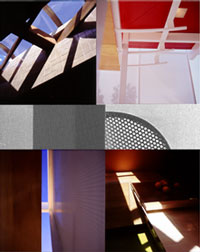| Architosh founder Anthony Frausto-Robledo
interviewed M. J. Neal this winter
about his very exciting work, much of which is highly engaging modern
architecture, deeply rooted into the place of Austin, Texas.

AFR
MJ thanks for taking the time to talk to us. First off I would like
to say I really like your work and the things you are doing on the
Mac.
MJ
Thanks very much.
AFR
Let me start off with some background stuff so we can get to know
you. So you are a native of Texas and went to college there as well.
What prompted you to go to Los Angeles after you graduated from
architecture school ?
MJ Well...Texas had a huge
bust in the mid 80's and there was a mass exodus of architects from
here. Some of us went West and others went East. I just happened
to go to LA.
AFR When
you were in Los Angeles, you worked for a few different firms..did
you bring anything exciting back from your 'LA experience' ?
MJ Yes. The first firm I
worked for was William Brantley Architects. He really considered
himself more of a sculptor than an architect. And so he really dealt
with things as a sculptor rather than an architect. He dealt with
things in a sculptural way that was really interesting to to be
a part of. And then Frank Fitzgibbons..who is just a wonderful architect—a
wonderful man too—he had actually worked for Meier, Giurgola
and Breuer...so it's like he passed on a heritage coming directly
from the Bauhaus, just one person removed from Breuer who was actually
over at the Bauhaus.

AFR Right, so you are kind
of naturally inclined toward Modernism then?
MJ Yes.
I always have been, even in school. You know the Post Modern thing
was really pervasive when I was in college and I actually thought
it was very distasteful.
AFR Can you tell me a little
about your fine arts training?
|
|
MJ Well, I actually have been
drawing since I was a little kid. I remember asking my Mom as a
small kid how to draw people and she'd draw stick figures...I have
always been interested in drawing people. So a lot of my artwork
deals with the human figure, or more an abstraction of it into some
kind of figurative art.
While I haven't done it in many years I was really working with
these 16 to 18 feet long by 6 feet high...really large canvases...and
really abstracting the body out, trying to capture a sensual quality.

AFR I thought that it was very interesting that you were
working with a filmmaker and focusing on restaurant design. Can
you talk a little bit about that? What were you trying to accomplish
by working with a filmmaker in architecture?
MJ Well, I have always been interested in movie making and
have worked in that industry some. For some reason, I have been
around a lot of theater people and movie people since college; I
don't know why they keep coming into my life!
Restaurants themselves can have a real theatricality to them. They
can become an event of sorts, a ritual people don't even realize
they are a part of. With Darrell, we wanted to capture the theatrical
possibilities of a restaurant setting by combining our talents.
AFR You are not only talking about architecture as stage
but trying to arrive at an architecture that raises itself to the
level of theatricality in terms of expression.
MJ Absolutely, I think that would be certainly
one way to put it. It really does raise itself to theater. But also
-- to use a really old cliché -- the 'whole world's a stage'
-- and so if we can do these restaurants that really engage your
senses, manipulating your whole experience, from the entrance to
the food, how you are directed into the space, how you feel where
you sit....the way the light comes in, the surfaces of the materials...everything
to the flatware, then you are elevating that experience of architecture.
|
"That's
using the term 'vernacular' in its true sense, 'of the place
itself'."
|
AFR How would you describe the architectural
culture in Austin today and where do you see your firm's role in
that?
MJ Well...I was pretty frustrated a couple
years ago by what is going on here. There are some people doing
some really nice stuff, what you would term as classical Texas vernacular,
where they are using a lot of materials and things and expressing
them in a way that is really responding, maybe, to the Texas past.
But a lot of what has happened down here is really
bad. And there really isn't a whole lot of modern architecture going
on. And I think we can do very vernacular contextual architecture
and still have it be very modern. That's using the term 'vernacular'
in its true sense, 'of the place itself'
.

|






![]()